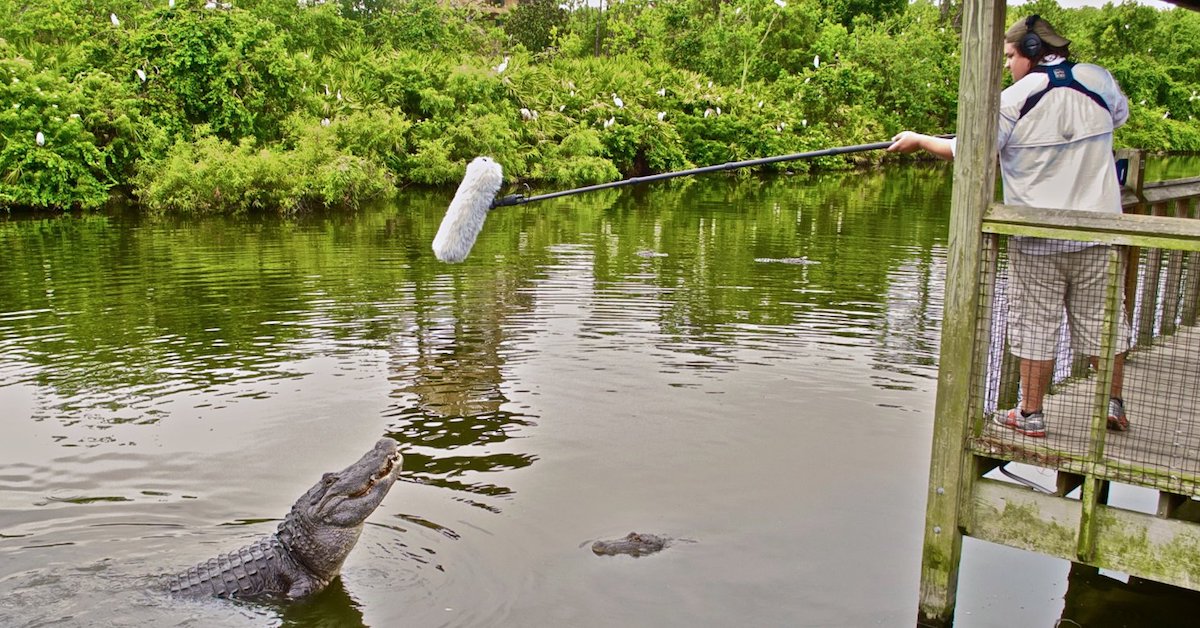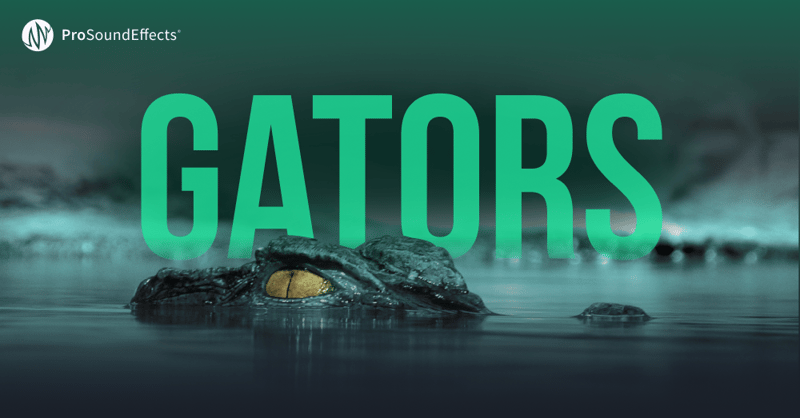Recordist of the Gators library shares the story of the collection's rigorous recording process.
The stunning alligator sound effects featured in Gators, our latest specialty library, are both the stuff of nightmares and a sound designer's dream for creature source. Massive, terrifying, larger-than-life growls, snarls, bellows, and hisses will add power and intensity to your creature vocals in any audio project.
But capturing these unbelievable sounds is no simple feat. In fact, alligators are typically very quiet, stealthy creatures. Luckily, recordist Colin Hart embarked on several excursions to the swamps of Florida to develop a method for cueing the monstrous sounds from these cold-blooded beasts – so you don’t have to.
We asked Colin to share the story behind the incredible recording process for Gators to give you an idea of the time and effort that went into such a one-of-a-kind sound effects library.
Article by Colin Hart.
Way back in another place and another life, I discovered that there was an alligator theme park only 30 minutes from my home. I had no idea what an alligator sounded like, but I figured it was probably pretty cool; so I called up the park, scheduled a private tour, and unknowingly set out on a journey that would take seven years to complete.
Back in June of 2011, my buddy Johnny and I, along with a couple of interns, showed up at this crazy, redneck-looking theme park in the middle of the swamps of Central Florida. We got there around 6am with a car full of gear and absolutely no idea what to expect. Our contact, Tim, showed up in a heavily modified old-school Jeep Wrangler with no top and fabric doors. He was already halfway through a massive cigar, wore all camo, had a big white mustache, and carried a giant stick with him. Sort of reminded me of the Florida version of Hammond from Jurassic Park.
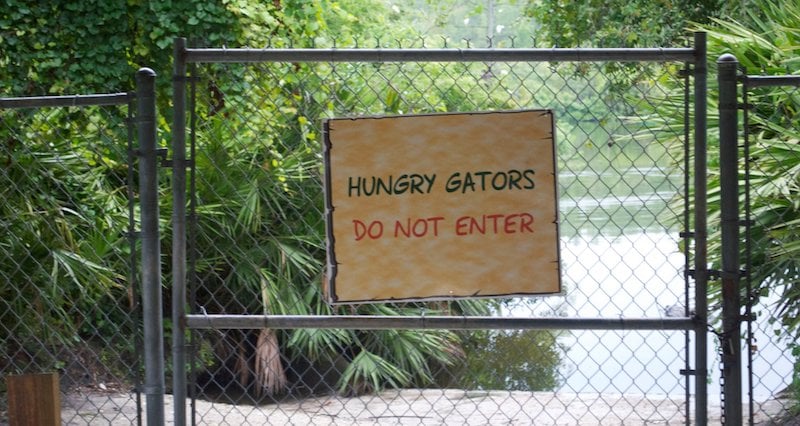
Here's an excerpt from a blog I wrote about the initial experience in 2011:
So our first stop on the tour was Chester’s Pen. Chester is nicknamed “The Dog Eater” because he used to terrorize neighborhoods in the area. When they caught him, the park adopted him so they didn’t have to put him down. Anyways, Chester is a 13.5 footer who lives in his own pen because he doesn’t get along with the other guys. He doesn’t much get along with anyone, really, which is apparently why Tim brought us in.
Tim explained to us what types of sounds we might hear. Gators don’t have any vocal chords, so any sounds they make are from forcing air through their throats and lungs, etc. They often hiss at you, which is a warning to stay away. They will also snap their jaws at you, which is a territorial thing. They can also grunt, growl, and bellow. So we prepped our levels the best we could – we set our gain a bit lower, just in case.
An important fact that I didn't know at the time was that alligators don't make a whole lot of sound outside of mating season – at least not many interesting ones. So I made plans to return in March, when gator mating season typically started.
So, fast forward to 2012…
We arrived, again, at 6am, again, with a car full of gear and barely a clue what to expect, again. At least this time we knew the park grounds, and we'd heard a distant bellow once before. We headed straight to the gator marsh, since that's where we expected most of the action.
We wanted as many bellows as possible.
Bellowing is where a gator raises it’s head and tail out of the water, fills it’s lungs with air, and then forces the air out in a way that causes a violent vibration. This vibration creates a terrifying sound – two sounds actually. The first one is between 10-19Hz (depending on the size of the gator), and causes the alligator’s entire back and tail to shake. It's barely audible, but it shakes the ground! This powerful infrasonic frequency causes the water all around the gator to do a little dance (interestingly, in a Faraday wave pattern!). That sound quickly transitions into a very audible sound from the gator’s throat.
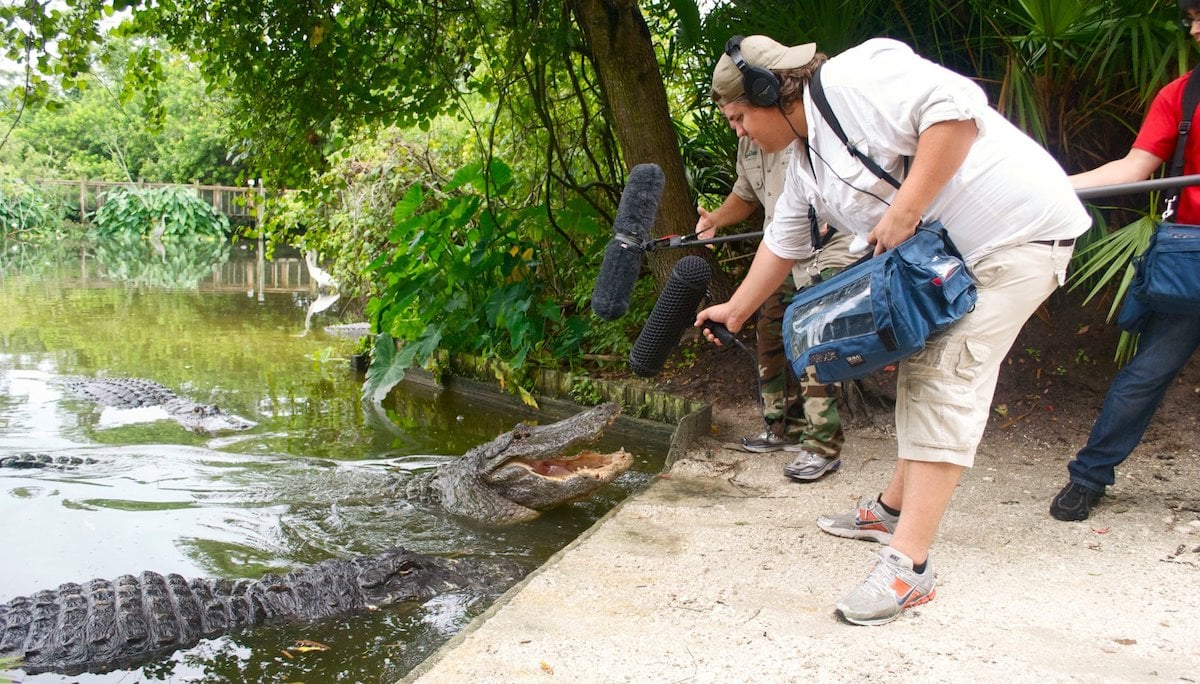
These sounds were absolutely UNBELIEVABLE up close!
At first, we just ran around as stealthily as possible (gators actually startle quite easily, which seems odd to me...), recording what we could. The gators were typically only vocally active between 7:30 and 9:30am, if we were lucky, and the park opened at 10am (crowds, music, etc.). It was a bit of an inefficient way to record, but it's what we had. To boot, the bellows were incredibly difficult to record cleanly, as the experience was a combination of loud birds, overlapping gators, and a nearby highway. So I decided to come back again. And again. And again... learning a bit more every time...
With some help from some seriously seasoned recordists like Ann Kroeber and David Farmer, I started figuring out a system to try to cue the gators. It started with small speakers that didn't seem to do anything, and slowly got bigger. The first bit of success (read: ANY reaction at ALL from the gators) was playing back our own alligator recordings through a 15" beat up old JBL EON in an old baby stroller.
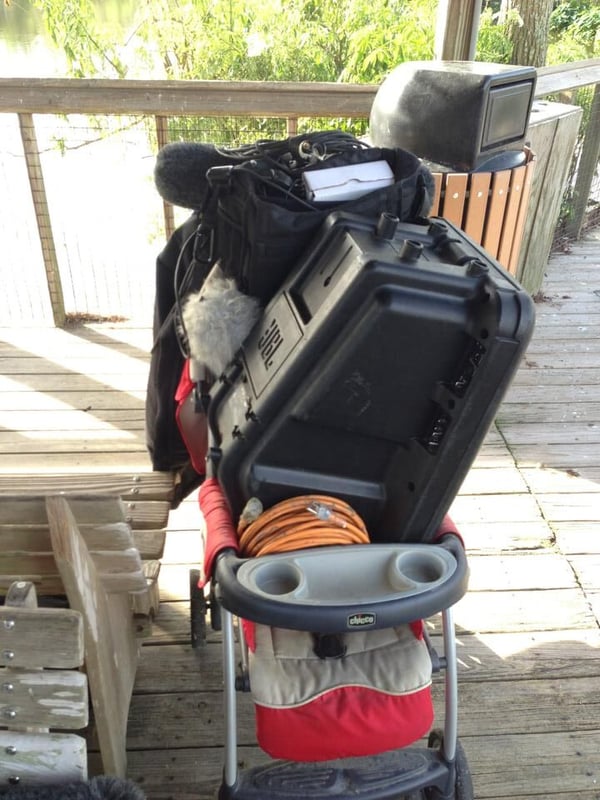
And by "any" reaction, I mean, the gators sort of lined up in a semicircle around us like children at story time. They were definitely interested, but they didn't perceive the sound we were playing as a territorial challenge, which is what we were going for. Eventually, though, they started bellowing, slowly at first... but we ended up having one of the most successful recording days so far, though I have no idea if that had more to do with our genius speaker or our dumb luck.
Eventually I ended up with enough usable sounds to make a small release. Armed with iZotope RX4 Advanced and a limited knowledge of library construction, I set out to clean up as many recordings as possible to create my "Hart a Gator" library. It went over tremendously well.
What a lot of people don't know, is that I kept recording for another 3 years after the original release. Over that time, we perfected our bellow cueing technique. Many iterations after our original "JBL in a baby stroller" playback system, we ended up with a GIANT subwoofer on the back of a truck that was backed up to the marsh. The subs were installed in sonotubes - the system was designed and tuned by Bruce Thigpen, of Eminent Technology. He designs rotary subwoofers that Boeing uses to test the limits of their airplanes! They've been known to crack foundations! (true)
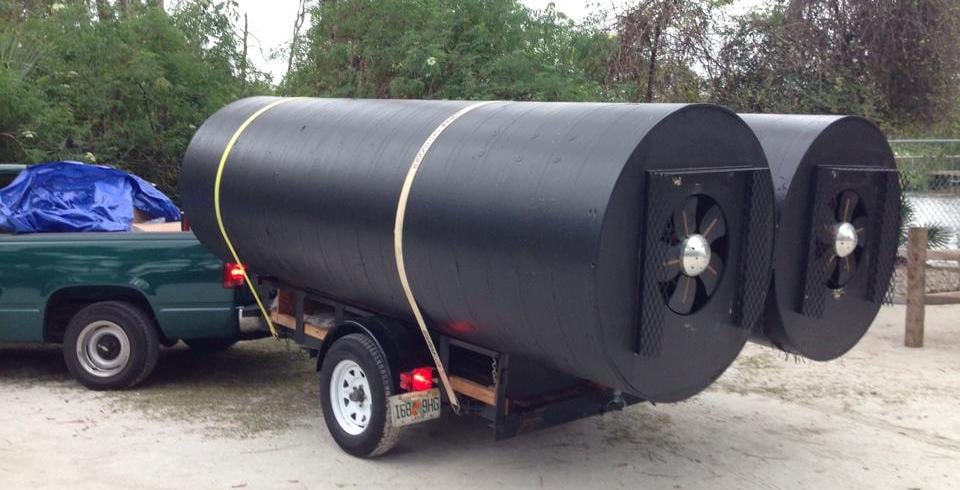
So these massive tubes were tuned to the median frequency of the infrasonic portion of the bellowing in my original recordings, and we played back the bellows through this system. It could produce 17hz at a shirt and teeth rattling 135db!
Lo and behold, the alligators responded with a chorus of bellows, EVERY. SINGLE. TIME! It was incredible! The owners of the park were intently considering buying a similar system to cue the gators at the park more often…
Mind you, this didn't make recording much easier, just a little more efficient and predictable. I needed a LOT of raw material to make this work.
So I spent as much time as I could recording these guys while I had this giant bellow inducing machine available. Most of the recordings were done with a Neumann KMR81, a Sanken CS-3e, and even an Aquarian H2a Hydrophone, all into my trusty Sound Devices 702 and 744.
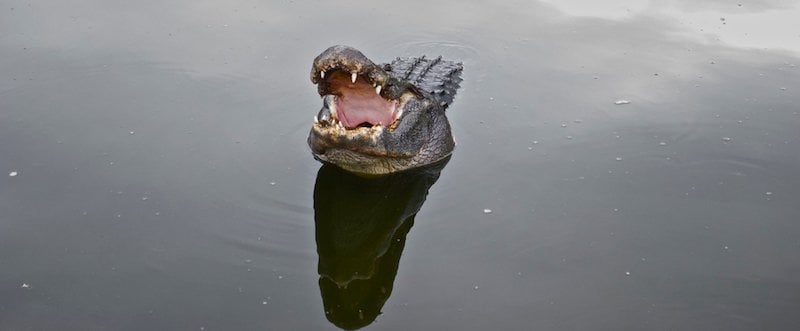
By the end of my gator recording phase, I had several years worth of recordings sitting on my hard drives, but there was a big elephant in the room that kept me from releasing any of it - the BIRDS! Since this was a giant pond full of gators, there were HUNDREDS of noisy birds that used the area as a sanctuary. The gators kept the egg-stealing predators away (mainly raccoons and weasels), and the birds were safe. Unfortunately, gator mating season overlaps with noisy bird hatching season, so nary a clean recording was in sight... I struggled clean them up with RX4, then let them rest a while. Then life happened, and they sat stagnant on my hard drives, collecting digital dust.
Fast forward a few years, and RX6 Advanced was released. I had been using it on all sorts of projects. One day, I remembered all these unedited gator sounds burning a hole in my hard drives. I figured I'd see if RX6 Advanced could do any better than RX4 did years before (add to that a number of years' worth of continuous RX experience).
Much to my delight, it was a great success! I was able to clean up enough of the recordings to the level I thought acceptable for a commercial release. The new content was twice as big as my original library! In the process, I ended up recutting and remastering the old library as well, now with new and improved bird removal, and it is included with the new. This is an impressively large alligator library! And it's still the only product of its kind!
So please take a listen to these guys, and pick up your copy on the Pro Sound Effects website! It will help support my nature chasing habit :-)
Thanks for dropping by, and feel free to find me on Facebook, IG, or Twitter to talk shop!

Follow Colin Hart:
Facebook
Instagram
Twitter


